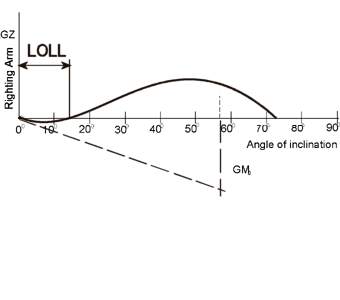
Angle of loll
Encyclopedia

Ship stability
Ship stability is an area of naval architecture and ship design that deals with how a ship behaves at sea, both in still water and in waves. Stability calculations focus on the center of gravity and center of buoyancy of vessels and on how these interact....
) and therefore takes on an angle of heel to either port or starboard.
When a vessel has negative GM i.e., is in unstable equilibrium, any external force, if applied the vessel, will cause it to start heeling. As it heels, its the waterline's moment of inertia increases, which increases the vessel's BM (distance from the center of buoyancy to the metacenter). Since there is no change in KB (distance from the keel to the center of buoyancy) of the vessel, the KM (distance from keel to the metacenter) of the vessel increases.
At some angle of heel (say 10°), KM will increase sufficiently equal to KG (distance from the keel to the center of gravity), thus making GM of vessel equal to zero. When this occurs, the vessel goes to neutral equibrium, and the angle of heel at which it happens is called angle of loll,
In other words, when an unstable vessel heels over towards a progressively increasing angle of heel, at a certain angle of heel, the center of buoyancy (B) may fall vertically below the center of gravity (G). Note that Angle of List should not be confused with angle of loll. Angle of List is caused by unequal loading on either side of center line of vessel.
Although vessel at angle of loll does display features of stable equilibrium, it is an extremely dangerous situation, timely remedial action is required to prevent the vessel from capsizing.
It is often caused by the influence of a large free surface
Free surface
In physics, a free surface is the surface of a fluid that is subject to constant perpendicular normal stress and zero parallel shear stress,such as the boundary between two homogenous fluids,for example liquid water and the air in the Earth's atmosphere...
or the loss of stability due to damaged compartments. It is different from list in that the vessel is not induced to heel to one side or the other by the distribution of weight, it is merely incapable of maintaining a zero heel attitude.

